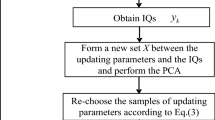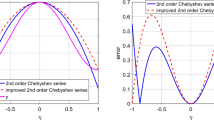Abstract
In order to improve the accuracy and credibility of the dynamic simulation model of the coordination mechanism, a general simulation model validation and updating framework was proposed. First, the dynamic model of the coordination mechanism was established considering two friction models. Then, in order to validate the accuracy of the simulation model, for the high-dimensional uncertainty, a validation method of the coordination simulation model based on principal component analysis-area index was proposed. Aiming at the problem that the simulation model was unreliable, a simulation model updating method based on parameter identification was proposed. Finally, the correctness and effectiveness of the method were verified, and the result showed that the accuracy of the simulation updating model with identified LuGre friction model was improved by 31.03 % than the one with identified Coulomb friction model. Thus, the accuracy and credibility of the coordination mechanism simulation model were greatly improved. It provides a theoretical support for the simulation model validation & updating of the coordination mechanism and other mechanical mechanisms.
Similar content being viewed by others
Abbreviations
- M :
-
The mass of the coordination arm
- A 1 :
-
The areas of the cylinder piston without rod cavity
- A 2 :
-
The areas of the cylinder piston with rod cavity
- p 1 :
-
The pressures of the cylinder piston without rod cavity
- p 2 :
-
The pressures of the cylinder piston with rod cavity
- F t :
-
Tangential friction
- F n :
-
Normal positive pressure
- c f :
-
Sliding friction coefficient
- c d :
-
Dynamic correction coefficient
- v t :
-
Relative tangential velocity
- z(t):
-
The average elastic deformation of bristles
- v s :
-
The StriBeck velocity
- F s :
-
The maximum static friction
- λ 0 :
-
The stiffness coefficient of bristles
- λ 1 :
-
The damping coefficient of bristles
- λ 2 :
-
The viscosity coefficient of bristles
- F f(t):
-
The LuGre friction force
- q :
-
The relative displacement
- \({{\boldsymbol{\dot q}}}\) :
-
The relative velocity
- \({{\boldsymbol{\ddot q}}}\) :
-
The relative acceleration
- M(q,t):
-
The mass matrix
- C(q,q,t):
-
The generalized damping matrix
- Q :
-
The external force matrix
- F s(y):
-
The CDF of the simulation prediction model
- S t(y):
-
The ECDF of the experimental data
- d(F s, S t):
-
Minkowski-L1 distance
- Σ :
-
The covariance matrix
- p k :
-
The principal component
- c k :
-
The contribution rate
- α :
-
The set of parameters to be identified of the coordination model
- x(t i):
-
The value of the simulated displacement
- X(t i):
-
The value of the tested displacement
References
G. Li, Research on accurate localization methods for mobile manipulator in complex industrial environments, Ph.D. Thesis, Huazhong University of Science and Technology, Wuhan, China (2016).
X. X. Gao, Action reliability and fault diagnosis of ammunition automatic loading subsystem, Ph.D. Thesis, Nanjing University of Science and Technology, Nanjing, China (2016).
Z. Q. Chen, L. F. Qian and G. S. Chen, Dynamics of luffing motion of a hydraulically driven shell manipulator with revolute clearance joints, Defence Technology, 18 (4) (2022) 689–708.
J. H. Zhang, X. L. Xu and X. Liu, Relative dynamic modeling of dual-arm coordination robot, Journal of Mechanical Engineering, 55 (3) (2019) 34–42.
D. Bao and B. L. Hou, Positioning reliability estimation of SDOF manipulator based on deep learning, Journal of Vibration and Shock, 40 (15) (2021) 246–252.
D. Bao, X. Liang and S. S. Ge, A deep motion reliability scheme for robotic operations, Mechanism and Machine Theory, 183 (2023) 105280.
Y. Liu, W. Chen and P. Arendt, Toward a better understanding of model validation metrics, Journal of Mechanical Design — Transactions of the ASME, 133 (7) (2011) 071005.
W. Chen, L. Baghdasaryan and T. Buranathiti, Model validation via uncertainty propagation and data transformations, AIAA Journal, 42 (7) (2004) 1406–1415.
Y. L. Li, X. J. Wang and C. Wang, Non-probabilistic Bayesian update method for model validation, Applied Mathematical Modelling, 58 (2018) 388–403.
P. H. Ni, J. Li and H. Hao, Probabilistic model updating via variational bayesian inference and adaptive gaussian process modeling, Computer Methods in Applied Mechanics and Engineering, 383 (2021) 113915.
W. L. Oberkampf and M. F. Barone, Measures of agreement between computation and experiment: validation metrics, Journal of Computational Physics, 217 (1) (2006) 5–36.
W. L. Oberkampf and T. G. Trucano, Verification and validation in computational fluid dynamics, Progress in Aerospace Sciences, 38 (2) (2002) 209–272.
S. Ferson, W. L. Oberkampf and L. Ginzburg, Model validation and predictive capability for the thermal challenge problem, Computer Methods in Applied Mechanics and Engineering, 197 (29) (2008) 2408–2430.
S. Ferson and W. L. Oberkampf, Validation of imprecise probability models, Internatinal Journal of Reliability and Safety, 3 (1) (2009) 3–22.
W. LI, Credibility of computational models built on uncertainty analyses and model validation, Ph.D. Thesis, Northwestern Polytechnical University, Xi’an, China (2015).
W. Li, W. Chen and Z. Jiang, New validation metrics for models with multiple correlated responses, Reliability Engineering and Systems Safety, 127 (6) (2014) 1–11.
L. Y. Li and Z. Z. Lu, A new method for model validation with multivariate output, Reliability Engineering and System Safety, 169 (2018) 579–592.
J. R. Hu and Z. Z. Lu, Model validation method with multivariate output based on kernel principal component analysis, Journal of Beijing University of Aeronautics and Astronautics, 43 (7) (2017) 1470–1480.
S. L. Lin, W. Li and M. Yang, Multivariate validation method under correlation for simulation model, Acta Automatica Sinica, 45 (9) (2019) 1666–1678.
D. Li and J. Zhang, Finite element model updating through derivative-free optimization algorithm, Mechanical Systems and Signal Processing, 185 (2023) 109726.
M. Basile, C. Ludovic and R. Christian, Parameter identification and model updating in the context of nonlinear mechanical behaviors using a unified formulation of the modified constitutive relation error concept, Computer Methods in Applied Mechanics and Engineering, 345 (2019) 1094–1113.
P. H. Ni, Q. Li and Q. Han, Substructure approach for Bayesian probabilistic model updating using response reconstruction technique, Mechanical Systems and Signal Processing, 183 (2023) 109624.
M. Zhan, Q. T. Guo and L. Yue, Finite element model updating of jointed structure based on modal and strain frequency response function, Journal of Mechanical Science and Technology, 33 (10) (2019) 4583–4593.
T. Lin, L. F. Qian and Q. Yin, Dynamic modeling and parameter identification of a gun saddle ring, Defence Technology, 16 (2) (2020) 325–333.
X. M. Guan, S. J. Xie, G. Chen and M. Qu, Modal parameter identification by adaptive parameter domain with multiple genetic algorithms, Journal of Mechanical Science and Technology, 34 (12) (2020) 4965–4980.
Q. Q. Zhao and B. L. Hou, Identification of interval uncertainty parameters of a howitzer shell transfer arm, Acta Armamentarii, 38 (1) (2017) 35–42.
J. B. Wu, L. Cheng and Y. J. Guo, Dynamic modeling and parameter identification for a gantry-type automated fiber placement machine combined with hydraulic balance system and nonlinear friction, CIRP Journal of Manufacturing Science and Technology, 37 (2022) 388–400.
J. Ma, G. S. Chen and L. Ji, A general methodology to establish the contact force model for complex contacting surfaces, Mechanical Systems and Signal Processing, 140 (2020) 106678.
J. Ma, L. F. Qian and G. S. Chen, Dynamic analysis of mechanical systems with planar revolute joints with clearance, Mechanism and Machine Theory, 94 (2015) 148–164.
Z. Zhou, X. D. Zheng and Q. Wang, Modeling and simulation of point contact multibody system dynamics based on the 2D LuGre friction model, Mechanism and Machine Theory, 158 (2021) 104244.
M. Filipe, W. Tukasz and W. Marek, An investigation of a novel LuGre-based friction force model, Mechanism and Machine Theory, 166 (2021) 104493.
G. S. Chen, The study on the dynamic of the projectile-barrel coupled system and the corresponding key parameters, Ph.D. Thesis, Nanjing University of Science and Technology, Nanjing, China (2016). China (2016).
D. S. Bae, J. M. Han and J. H. Choi, An implementation method for constrained flexible multibody dynamics using a virtual body and joint, Multibody System Dynamics, 4 (2000) 297–315.
J. L. Deutsch and V. D. Clayton, Latin hypercube sampling with multidimensional uniformity, Journal of Statistical Planning and Inference, 142 (2012) 763–772.
Acknowledgments
This work is supported by Scientific Research Foundation for High-level Talents of Nanjing Institute of Technology (grant number YKJ202104), China. The authors also gratefully thank the editors and reviewers of this manuscript.
Author information
Authors and Affiliations
Corresponding author
Additional information
T. S. Liu works at the Nanjing Institute of Technology. He received his Ph.D. in the School of Mechanical Engineering, Nanjing University of Science and Technology, Nanjing, P. R. China. His current research interests include simulation model validation & model updating, robust optimization design, data driven, machine learning and digital twins.
Y. Y. Niu is an undergraduate of the Nanjing Institute of Technology, Nanjing, P. R. China. His current research interests include simulation modeling, model validation & model updating, mechanism control.
G. S. Chen is a Professor of the Nanjing University of Science and Technology. He received his Ph.D. in the School of Mechanical Engineering, Nanjing University of Science and Technology, Nanjing, P. R. China. His current research interests include simulation model validation & model updating, finite element analysis, fault diagnosis, machine learning and digital twins.
Rights and permissions
About this article
Cite this article
Liu, T., Niu, Y. & Chen, G. A general methodology for simulation model validation and model updating of the coordination mechanism with uncertainty. J Mech Sci Technol 37, 6271–6286 (2023). https://doi.org/10.1007/s12206-023-1105-2
Received:
Revised:
Accepted:
Published:
Issue Date:
DOI: https://doi.org/10.1007/s12206-023-1105-2




